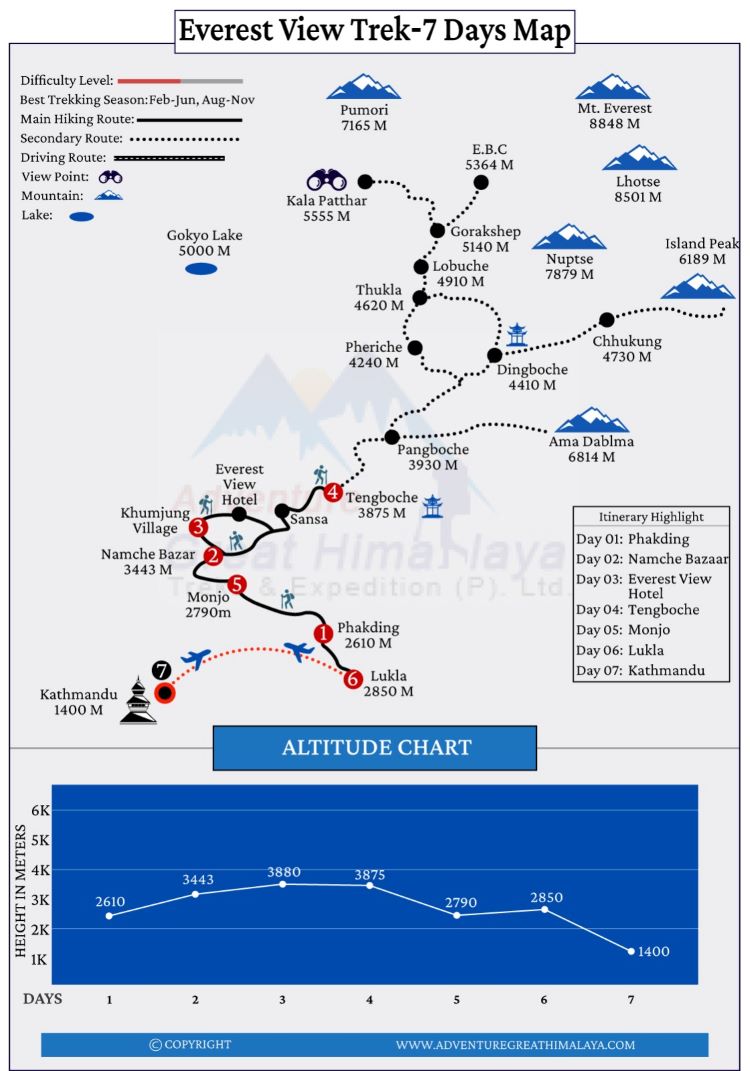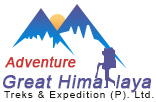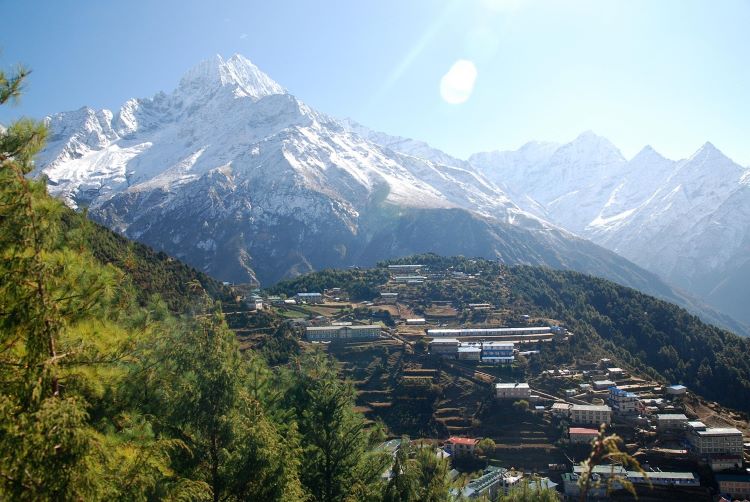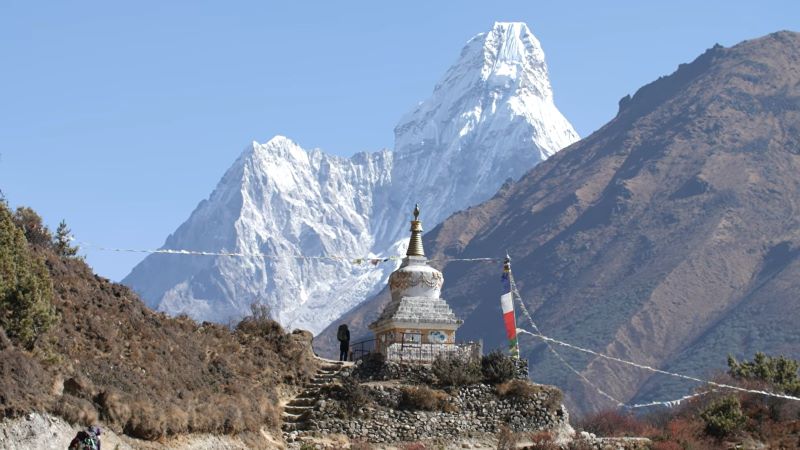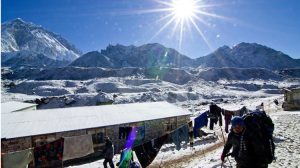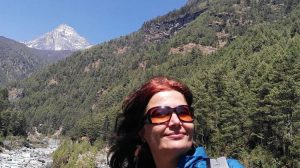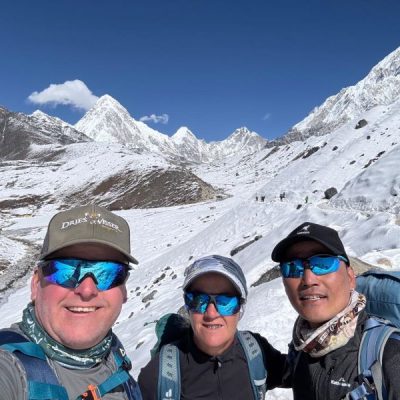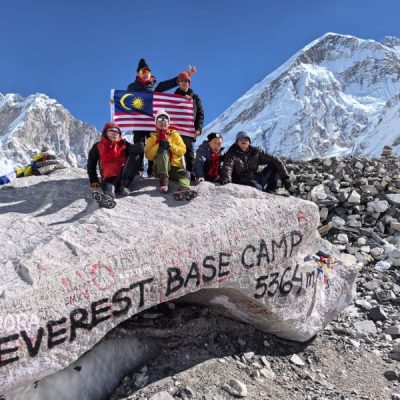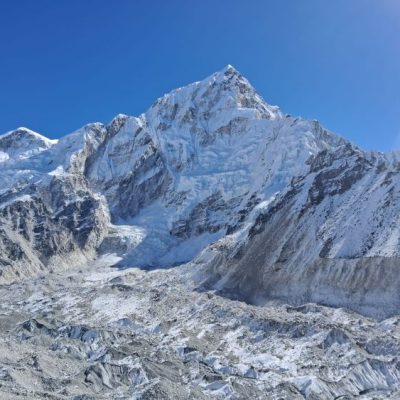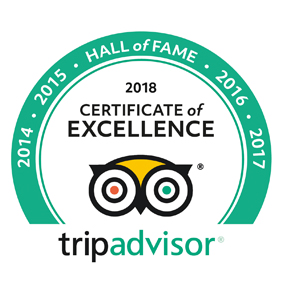Overview
The 7 days Mount Everest View Trek is a popular trekking route in the Everest region of Nepal, offering stunning views of the world’s highest peaks, including Mount Everest (known as Sagarmatha in Nepali) itself. This trek is ideal for those who want to experience the beauty of the Himalayas without committing to the more strenuous and lengthy Everest Base Camp trek.
One of the highlights of the Everest View Trek is the opportunity to experience Sherpa culture firsthand, as trekkers interact with local villagers and learn about their traditions and way of life. The trek usually takes around 7 to 10 days to complete, depending on the itinerary and pace.
The Everest View Trek typically begins with a scenic flight from Kathmandu to Lukla, where the trekking adventure commences. The route passes through picturesque Sherpa villages, rhododendron forests, and high-altitude landscapes. Along the way, trekkers often visit famous viewpoints like Namche Bazaar, Tengboche Monastery, and Khumjung Village, where they can enjoy panoramic views of Everest and other towering peaks.
Overall, the Everest View Trek offers a memorable journey into the heart of the Himalayas, providing awe-inspiring scenery and cultural encounters along the way. It’s a fantastic option for trekkers of varying experience levels who want to witness the majesty of Everest up close.
Highlight of Everest View Trek 7 Days
- Sunrise and Sun Set Views of World Tallest peak Mt. Everest (8848m), and numerous others
- Visit The Tengboche Monastery, the largest monasteries in the Everest region ( Live there more than 35 Monks
- Closely observe the unique culture and lifestyle of the legendary Sherpa people
- Hiking through of World Heritage Sites of Nepal listed by UNESCO Sagarmatha National Park
When to Go?
Out of the 12 months in a year, there are three specific months in Nepal that offer fantastic weather conditions for trekking. The ideal time for Everest View Trek is during the spring season, which starts from March and continues till May.
Another excellent period for Everest view trekking is during autumn, which typically spans from the end of September to mid-December. Surprisingly, winter can also be a favorable time to go trekking in Nepal; it extends from December to February. However, it’s important to note that the harshest weather conditions occur during peak winter months (December to February).
During the monsoon period in Nepal, which occurs from June to August, there is a significant amount of rainfall. This can make the trail slippery and obstruct views of the Himalayas. However, trekking is still possible during this time.
The best time for Everest trek is during Autumn (September-December) and Spring (March-May). Winter trekking to Everest view point is also feasible, although temperatures can drop to extreme levels. Despite the cold and snowy conditions, the weather during these months is generally excellent. If you choose to trek during winter, it is recommended that you bring warm clothing and a sleeping bag for overnight stays.
Accommodation on Everest View Trek
The Everest region is renowned for its Sherpa communities, who inhabit the areas. When venturing on the Everst trekking trail, one will encounter numerous Sherpa villages. Throughout this teahouse trek, you will hop from one village to another for your overnight stays. Along the way, there are several stopovers such as Lukla, Phakding, Namche Bazaar, and Tengboche that offer a variety of teahouses.
Everest trek accommodation is provided in these traditional teahouses. These structures resemble mountain lodges found in the European Alps and provide basic lodging facilities to trekkers. Each teahouse typically has twin beds with comfortable foam mattresses along with pillows and quilts for a good night’s rest. To keep guests warm during chilly nights or mornings, Bukhara stoves are commonly found in the dining areas of these lodges. Hot water shower facilitieis are available at an additional cost while wifi services can also be accessed for an extra charge.
Available Meals and Drinks
We will Provide 3 meals a day during The trek. These meals consist of breakfast at the hotel before starting the trek, lunch during a designated rest stop, and dinner at the night’s destination. The food options available during the trek are diverse and include popular Nepali dishes such as Daal Bhaat, which consists of rice, lentils, soup, vegetable curry, and pickle.
In addition to these traditional dishes, teahouses along the route offer a wide range of cuisines from Chinese and Indian to Italian and French. Visitors can enjoy noodles, mashed potatoes,french fries,pies,pasta,cutlets,and other options in most places. It is important to inform us about your meal preferences so that we can accommodate them accordingly.
We understand that food choices are personal and varied; therefore we strive to provide a variety of options to cater to individual tastes while maintaining quality standards throughout your trekking experience on Everest.
Physical Requirements
The Short Everest view Trekking encompasses a range of elevations, starting at 2800 meters at Lukla and reaching up to 3860 meters at the Tyangboche monastery.. The varying altitude levels of this trek contribute to its moderate level of difficulty. Individuals undertaking this journey must be mentally and physically prepared.
Our trek entails walking for 5-7 hours each day on challenging terrain consisting of mud and rocks. Additionally, we will spend three days above the 3000-meter mark.
To ensure a successful trekking experience, it is recommended that you commence your fitness training at least one month prior to your travel date. We advise focusing on cardio exercises such as cycling, using the treadmill, jogging, and hiking in order to enhance your stamina and lung capacity. Furthermore, endurance training activities like weight liting and sprinting can aid in strengthening muscles which is crucial for completing this traverse successfully.
The difficulty of Everest View Trek depends on an individual’s fitness level. It may prove arduous for beginner trekkers but relatively easier for those with previous experience. Therefore, it is always preferable to be in excellent physical condition in order to enjoy a comfortable trekking adventure
Details Itinerary
Cost Include/Exclude
What’s include
- Meals In Trekking: 3 Times meals a day (Breakfast, Lunch and Dinner) during the trek.
- Hot Drinks – Tea / Coffee with Meals
- Trekking Permit and All necessary paper works.
- Domestic Flight ticket: Flight ticket Kathmandu / Lukla / Kathmandu.
- Accommodation in Trekking: All accommodations in lodges/tea houses during the trek.
- Trekking Guide: An experienced, helpful, friendly and Good English speaking guide
- Trekking Porter– Carry your bag pack ( 1 porter for 2 members) No Porter for Solo Trekkers
- Trekking Equipment: Sleeping bag, down jackets, Duffie bag and walking stick, if necessary ( Refundable after trek)
- Company T-shirt and Trekking map.
- Medical supplies (first aid kit will be available)
- All government taxes and service charge.
What’s excluded
- All the Bar bills and personal expenses (phone call, laundry service, battery recharge, Extra hot drinks
- Tips
- All the expenses from Out of our control such as flight delay, cancels, landslide etc,
Add -Ons
Accommodation with Private Bathroom– Hot Shower – USD 240 Per room
Extra Porter -USD 120 per porter
Kathmandu to Lukla or Lukla Kathmandu Helicopter– USD 500 per person Sharing Helicopter
Trip Map
